Pumps are the lifeblood of amusement park rides, water attractions, pools and spray parks. They facilitate the thrills, deliver the cooling enjoyment and provide the means of vehicle transportation throughout the leisure and attractions industries.
Water rides and attractions—such as Shoot the Chutes, log flume rides, super flumes, river rapids rides, fiberglass serpentine chutes and more recently, surfing attractions—are integral and popular components of any amusement, theme or water park. Today, some can even be found on cruise ships.
This article provides an overview of the major water attractions at amusement parks and the pumps that power them.
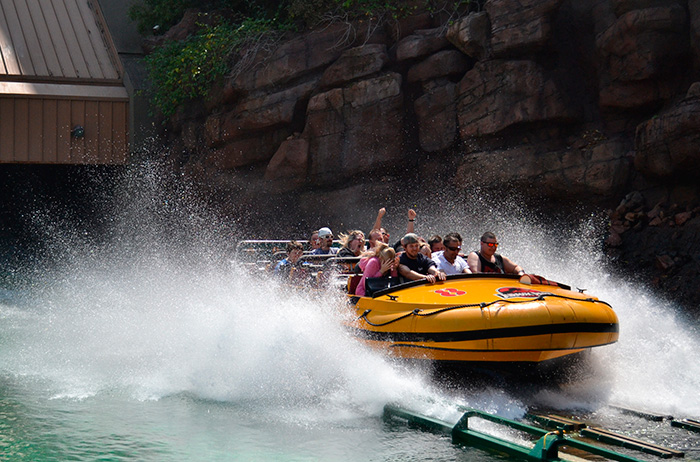
Shoot the Chutes
Shoot the Chute, the first type of amusement water thrill ride, was originally constructed in Rock Island, Illinois, in 1884. The ride located at Watchtower Park consisted of a boat that would carry patrons down 500-foot slide of greased wooden plank placed on the side of a hill, ending with a splash onto the lake. This attraction proved popular, and many more attractions of this type were constructed around the Midwest.
Components of the modern Shoot the Chute attraction include a flat-bottomed boat that generally seats from 12 to 24 guests, a powered uptake (lift chain or wide, rubber belt lift hill) that takes the boat up from the embarkation area to an upper trough and a steeply inclined drop. The upper horseshoe-shaped trough contains water that ends up spilling down the drop-track. This creates a visualization that the boat is coming over a waterfall or spillway. The boat travels down the steep decline, splashing down into the lower pond. The boat travels along the run-out track, causing an initial large splash. Because of the hull design, it also generates a huge water wall in front of the boat. Many parks use that wall of water to provide additional excitement as guests exiting the ride from the previous cycle can get drenched by that water swell.
Generally, two horizontally mounted, flow generating low-head submersible propeller pumps are installed near the passenger embarkation area in the lower pond to generate a steady current to propel the boat along the lower pond course. An additional submersible centrifugal pump is used to deliver approximately 5,000 to 6,000 gallons per minute of water to the upper ride trough supplying the waterfall effect.
Many custom attractions, such as Universal Studio’s Jurassic Park attraction, are derivatives of Shoot the Chute. With the Jurassic Park attraction, the boat vehicle begins the journey in a large pond where more than 40 small horizontal submersible propeller pumps, located along the channel pathway, generate a current that propels the boat along its heavily themed journey. After several mechanical lifts inside a themed building, the ride ends with a traditional Shoot the Chute drop and large splash run-out, soaking the riders.
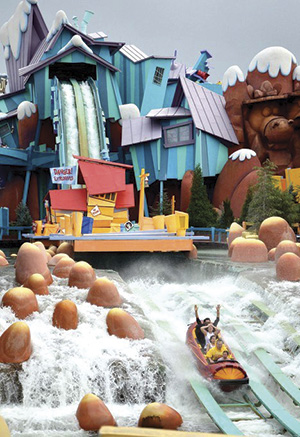 Dudley Do-Right log flume at Universal Studios’ Islands of Adventures
Dudley Do-Right log flume at Universal Studios’ Islands of AdventuresLog Flume Rides
The log flume ride is a cornerstone attraction of any amusement park. In fact, amusement park development experts list it as one of the top 10 attractions that every park needs. The first modern-day log flume was designed and constructed by Arrow Dynamics of Clearfield, Utah, at Six Flags Over Texas in 1963—a ride that remains in operation today.
One of the first heavily themed log flumes built was the Bud Hurlbut-designed Timber Mountain Log Ride at Knott’s Berry Farm. The ride trough of the Knott’s flume is enclosed within a structure, simulating the experience of traveling through an animated working saw mill.
Similar to Shoot the Chute, after embarkation, the log flume ride begins with a lift hill using a chain or rubber belt taking the four-to-six passenger, fiberglass faux log boat vehicle up to an elevated trough. Unlike the Shoot the Chute’s simple horseshoe-shaped upper trough, the log flume traverses a narrow serpentine channel, which provides twists and turns, ending with a thrilling steep descent and splash-down. Some log flume rides use two uptakes and two drops with the final drop being the most dramatic.
The Flume at Knoebel’s Amusement Park in Elysburg, Pennsylvania, is one example of a classic double-drop log flume ride. Reverchon Industries developed and sold a semi-portable log flume ride for large carnival operations that could be set up, dismantled and moved several times per season. Several of these semi-portable attractions are installed in fixed locations as well. Luna Park at New York’s Coney Island is one example of a fixed place Reverchon Log Flume. Electric submersible propeller pumps or conventional shafted axial flow propeller pumps deliver water for travel in the lower trough while a centrifugal pump generally delivers water for the upper trough.
Super Flumes
The super flume is a more recent derivative of the traditional log flume attraction. It uses larger and wider fiberglass log vehicles that can accommodate side by side or two riders per row, doubling the vehicle capacity and ride customer throughput. Walt Disney World’s Splash Mountain attraction is an example of a super flume. Electric submersible or conventional shafted axial flow propeller pumps and centrifugal pumps deliver water for travel throughout the attraction flume troughs.
River Rapids Rides
The first river rapid ride was developed in 1980 by Intamin Ltd. and was installed in Astroworld Park in Houston, Texas. The river rapids ride replicates a rafting trip down a narrow, winding, churning river.
Unlike Shoot the Chute and log flume rides, the lift hill or uptake is generally at the end of the attraction. The circular boats are configured for six to 12 passengers. Riders enter and exit the raft vehicles atop a large turntable. Once released, the raft begins its river journey.
The elevation drop from the ride embarkation point to the uptake belt generally ranges between 10 and 18 feet for most rides. Park guests enjoy getting splashed as the passenger rafts negotiate the serpentine river course. Along the way, guests encounter waterfalls, quiet pools, water sprays and turbulent river waters. Guests riding the river rapids expect to get wet, and—in most cases—they are not disappointed. Trough floor-mounted obstructions, such as large diameter pipes and timbers, create hydraulic jumps that simulate rapids for the enjoyment of the guests.
The O.D. Hopkins-designed Thunder River Rapids at Lake Compounce Park in Connecticut is an example of a typical river rapids ride, while the Barr Engineering-developed Popeye and Bluto Rapids Ride at Universal Studio’s Islands of Adventure Park and Intamin Ltd.-designed Walt Disney World Animal Kingdom’s Kali River Rapids are great examples of heavily themed river rapids rides. (See the sidebar at the end of the article for more about the Kali River Rapids ride and the pumps that power it.)

In most cases, several of the main flow pumps are large, electric submersible axial-flow propeller pumps that provide the river channel flow, although a few such attractions have used Archimedes screw-type pumps for the visual effects. Water delivered through show water and waterfalls is supplied by electric submersible centrifugal pumps or end suction centrifugal pumps.
Whitewater Kayak Facilities
Artificial whitewater kayak facilities became popular after the construction of a pumped course in Barcelona, Spain, for the 1992 Olympic Games. Since then, the Olympic Games held in Sydney, Australia, in 2000; Athens, Greece, in 2004; Beijing, China, in 2008; and London, England, in 2012 have constructed artificial whitewater courses.
Two man-made, pumped whitewater kayak courses operate in the U.S. The U.S. National Whitewater Course in Charlotte, North Carolina, opened in 2006. The following year, the Action Sports Center Inc. (ASCI) opened in McHenry, Maryland. All these attractions use large, electric submersible axial-flow propeller pumps to provide course flow.
By increasing or decreasing the number of operational pump units, the rapids class can be changed on the competition course. The largest courses can require nearly 450,000 gallons per minute to produce up to Class 4 rapids.
Fiberglass Serpentine Chutes
The brightly colored fiberglass serpentine chutes that twist and turn from the stair tower down to the splash-down pool are a staple of water parks. Serpentine chutes can now be found aboard several cruise ships adorning the upper-most deck near the traditional pools and provide endless hours of enjoyment to cruise guests.
Generally, guests grab a large inner tube and climb up the stair tower to the top of the structure, hop on the tube and slide down the fiberglass chute, propelled by the lubricating and cooling water splashing down in the end pool or ride run-out. Normally, end-suction centrifugal pumps deliver the water in a high-head, low-flow pump application.
Master Blaster
Some parks offer a fiberglass chute attraction in which the rider is propelled upward. In the late 1980s, Jeff Henry of Schlitterbahn Park perfected the Master Blaster, a ride in which a wide jet stream of water is sprayed along the bottom, upward-turning surface of a fiberglass trough that can propel the inflatable raft on uphill sections of the attraction.
The ride begins with the typical climb up the stair tower. Unlike the gravity drop of the serpentine fiberglass slide, the Master Blaster adds several uphill and helix components during which water jet blast components propel and add velocity to the rafts, enhancing the guests’ experience prior to the pool splash-down. End-suction centrifugal pumps provide the blasting component to this attraction.
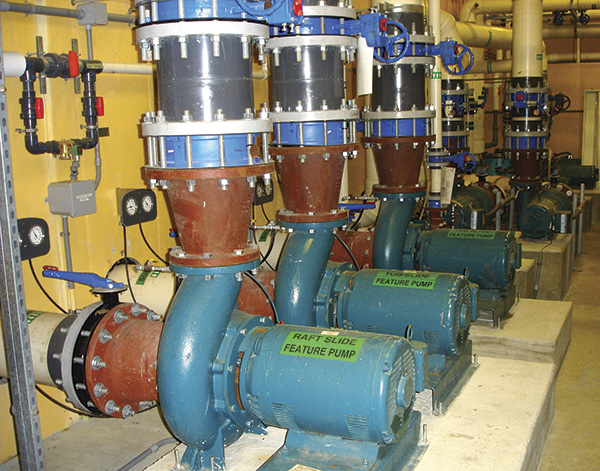 An operations room in the park houses the water ride pumps.
An operations room in the park houses the water ride pumps.Surfing Attractions
Some more recent and modern additions to the water attraction market are also available, including two prominent designs on the surfing attraction market. Developed in the late 1980s, a surfing attraction was the brainchild of Tom Lochtefeldt and his company WaveLoch, Inc.
The attraction employs horizontally mounted electric submersible propeller pumps mounted in a patented tube and nozzle system that delivers a 3-inch thick sheet flow of water that travels at approximately 30 miles per hour along a safe, upward sloping trampoline-like riding surface. The endless wave board riding attraction was born. Riders can lie flat, on their knees or standing and ride the wave.
In the 1990s, Royal Caribbean Cruise Lines began installing FlowRider attractions on the sports deck of their largest cruise ships. These attractions have proven so popular that FlowRiders are being retrofitted onto older Royal Caribbean Cruise Lines ships when in dry dock.
A further advancement, the barrel-type attraction, has a specially formed surface that develops a full surfing barrel wave. Bruce McFarland’s American Wave Machine design uses electric submersible pumps to produce a bulk flow within a channel in its SurfStream and PerfectSwell attractions. This design employs specific floor shapes to develop hydraulic jumps, producing surfing waves. The American Wave Machine allows surfers to use surf boards that have traditional surfboard tails.
Themed Boat Rides
Generally situated on flat ground, the themed boat ride is another theme park staple. Large boats carry riders along a gentle, quiet river course through a heavily themed attraction. The boat ride is not the activity: The water ride simply lets guests travel through the themed experience. Disney’s It’s a Small World and Pirates of the Caribbean attractions are examples of themed boat rides. Electric submersible propeller pumps provide large volumes of water at low heads, generating the required boat channel current.
Ride on Walt Disney’s Magic River
The Kali River Rapids in Walt Disney World’s Animal Kingdom opened to great fanfare in 1999. The river raft ride takes you on a tour through a lush jungle landscape that transforms into a “smoldering inferno of charred tree trunks,” according to the Disney website. Disney also promises that riders will get splashed—maybe even soaked. The ride’s geysers, jetting waters and splashdowns are powered by hidden pumps. The river rapids rides were pioneered by Intamin, which designed the first rafting ride down a narrow, winding, churning river at Houston’s Astroworld. Intamin also designed the Kali Rapids ride. Twelve riders are strapped into each Kali River raft. The ride is powered by pumps hidden from the view of riders, making the rapids even more magical.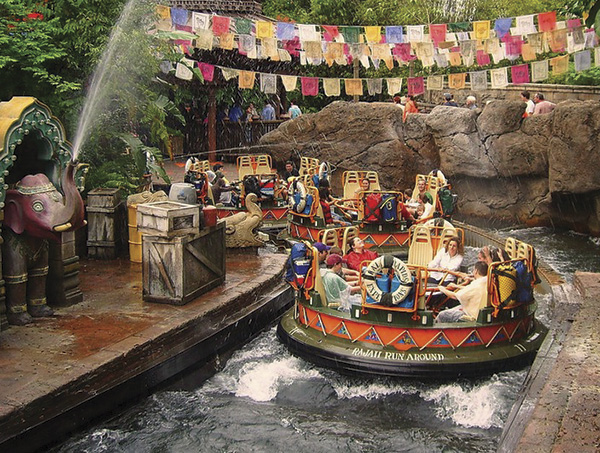 Kali River Rapids in Walt Disney World’s Animal Kingdom
Kali River Rapids in Walt Disney World’s Animal Kingdom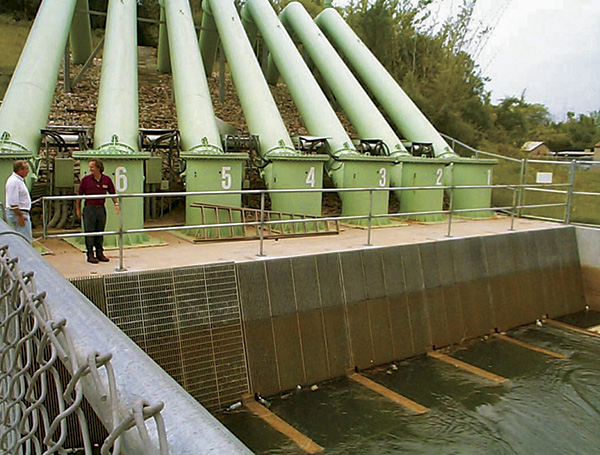 Pumps at Kali River Rapids in Walt Disney World’s Animal Kingdom
Pumps at Kali River Rapids in Walt Disney World’s Animal Kingdom

